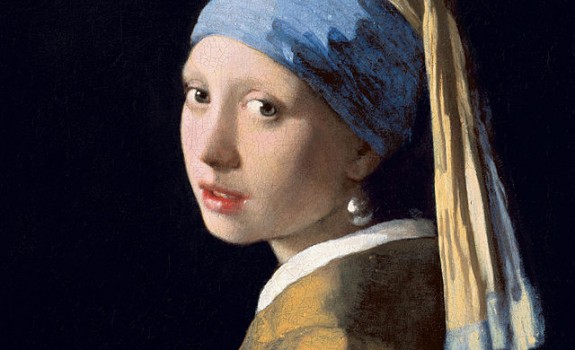Source image, text, and video: Wiki and Youtube
Johannes Vermeer (1632 – 1675) was a Dutch painter who specialized in domestic interior scenes of middle-class life. Vermeer was a moderately successful provincial genre painter in his lifetime. He seems never to have been particularly wealthy, leaving his wife and children in debt at his death, perhaps because he produced relatively few paintings.
Vermeer worked slowly and with great care, using bright colours and sometimes expensive pigments, with a preference for lapis lazuli and Indian yellow. He is particularly renowned for his masterly treatment and use of light in his work.
Vermeer painted mostly domestic interior scenes. “Almost all his paintings are apparently set in two smallish rooms in his house in Delft; they show the same furniture and decorations in various arrangements and they often portray the same people, mostly women.”
Vermeer may have first executed his paintings tonally, like most painters of his time, using either monochrome shades of grey, or a limited palette of browns and greys, over which more saturated colors (reds, yellows and blues) were applied in the form of transparent glazes. No drawings have been positively attributed to Vermeer, and his paintings offer few clues to preparatory methods.
There is no other seventeenth-century artist who early in his career employed, in the most lavish way, the exorbitantly expensive pigment lapis lazuli, or natural ultramarine. Vermeer not only used this in elements that are naturally of this colour; the earth colours umber and ochre should be understood as warm light within a painting’s strongly-lit interior, which reflects its multiple colours onto the wall. In this way, he created a world more perfect than any he had witnessed. This working method most probably was inspired by Vermeer’s understanding of Leonardo’s observations that the surface of every object partakes of the color of the adjacent object. This means that no object is ever seen entirely in its natural color.
A comparable but even more remarkable, yet effectual, use of natural ultramarine is in The Girl with a Wineglass. The shadows of the red satin dress are underpainted in natural ultramarine, and, owing to this underlying blue paint layer, the red lake and vermilion mixture applied over it acquires a slightly purple, cool and crisp appearance that is most powerful.
Vermeer’s works are largely genre pieces and portraits, with the exception of two cityscapes and two allegories. His subjects offer a cross-section of seventeenth-century Dutch society, ranging from the portrayal of a simple milkmaid at work, to the luxury and splendour of rich notables and merchantmen in their roomy houses. Besides these subjects, religious, poetical, musical, and scientific comments can also be found in his work. Among his best known works are Girl with a Pearl Earring (1665) and The Milkmaid (1658). Vermeer is acknowledged as one of the greatest painters of the Dutch Golden Age.

